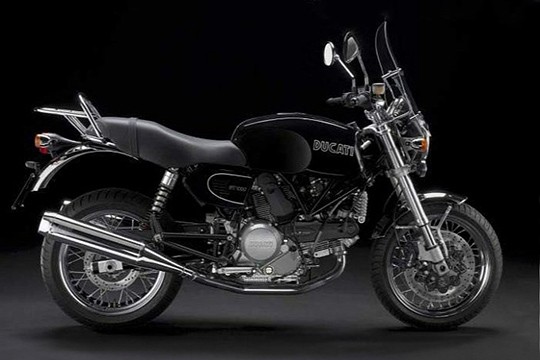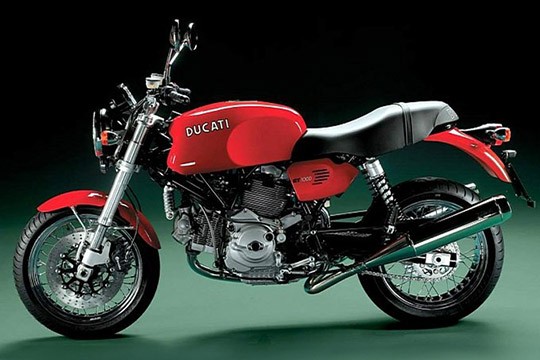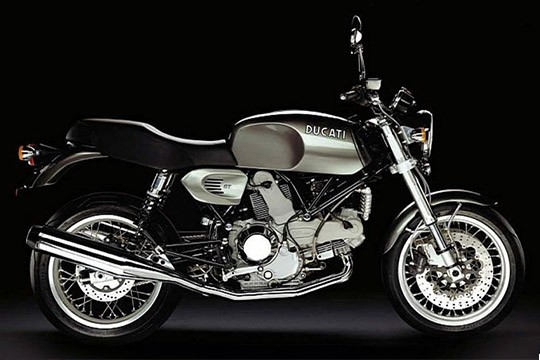DUCATI GT Models/Series Timeline, Specifications & Photos
First production year: 2007
The Ducati Sport Classics was a series of retro-styled motorcycles in Ducati's range. The bike was introduced at the 2003 Tokyo Motor Show and sold in 2005 as a 2006 model year. The bike came as a replacement for the Ducati MH900e model.
In 2010, alongside the standard GT 1000 model, the Italian motorcycle manufacturer launched the Ducati GT 1000 Touring. It was identical to the base model but with additional touring-oriented accessories.
In addition to its standard features, the GT 1000 Touring came with additional touring features, such as a detachable windscreen for better wind protection, passenger grab handles, a rear luggage rack, a more comfortable dual seat, and a revised suspension system.
In the performance department, the 2010 Ducati GT 1000 Touring had installed the same 992cc four-stroke L-twin air-cooled engine as the standard model, managed by a fuel injection system, delivering 82 hp at 8,000 rpm and 83 Nm (61 lb-ft) torque at 6,000 rpm.
The power produced by the engine was handled by a six-speed transmission with a wet multi-plate clutch and sent to the rear axle through a final chain drive.
The bike was built around a tubular steel trellis frame just like the one used on the Paul Smart and Sport 1000 versions, with the only difference being the addition of several mounting points for twin shock absorbers and side panels. In addition, all models packed the
The Ducati Sport Classics was a series of retro-styled machines in Ducati's range introduced in 2003 at the Tokyo Motor Show and put on sale in 2005 as a 2006 model year. The bikes replaced the Ducati MH900e model.
In 2010, the Italian motorcycle maker released the Ducati GT 1000, a standard motorcycle in its fourth year of production. It was built as a modern cruiser with excellent comfortability and safety levels offered by modern technologies.
The bike's aesthetic department was represented by standard features, such as lightweight wire-spoke wheels, a dual exhaust system with a muffler mounted on each side, dual side-mounted shock absorbers on the rear, a one-piece dual seat, and a large, round headlight on the front.
The bike was built around a tubular steel trellis frame similar to the Paul Smart and Sport 1000 versions, with the only difference being the addition of several mounting points for twin shock absorbers and side panels. In addition, all models packed the same 992cc engine.
A 43 mm fully adjustable inverted Marzocchi fork on the front and twin spring preload-adjustable Sachs shock absorbers on the rear offered excellent suspension performance and handling capabilities.
As for the power figures, the 2010 Ducati GT 1000 had installed a 992cc four-stroke L-twin air-cooled engine with a fuel injection system in charge, boasting 82 hp at 8,000 rpm and 83 Nm (61 lb-ft) torque at 6,000 rpm.
In 2009, the Italian motorcycle manufacturer launched the Ducati GT 1000, a standard motorcycle in its third year of production. The bike packed the same technical and performance specifications as the previous model without significant modifications, except for color alterations.
The Ducati GT 1000 was part of Ducati's Sport Classic series. It was a series of retro-styled motorcycles introduced at the 2003 Tokyo Motor Show and sold from 2005 as a 2006 model year.
The range comprised three models: the Pauls Smart version sold only in 2006, the Sport 1000 model made between 2006-2009, and the GT 1000 model manufactured between 2007 and 2010.
In the visual department, the bike was fitted with standard features, such as lightweight wire-spoke wheels, a dual exhaust system with a silencer mounted on each side, dual side-mounted shock absorbers on the rear, a one-piece dual seat, and a large, round headlight on the front.
As for the power figures, the 2009 Ducati GT 1000 had its heartbeat set by a 992cc four-stroke L-twin air-cooled engine fed by an electronically controlled fuel injection system, delivering an output power of 82 hp with maximum strength at 8,000 rpm and 83 Nm (61 lb-ft) torque at 6,000 rpm.
The bike was set in motion by a six-speed manual transmission fitted with a wet multi-plate clutch, spinning the rear through a final chain drive, pushing the motorcycle to a maximum top speed of 209 kph (130 mph).
In 2008, the Italian motorcycle manufacturer launched the Ducati GT 1000, a liter-class machine in its second year of production. The bike was developed by the House of Borgo Panigale and aimed primarily at the American market.
The 2008 motorcycle came with the same package as the previous model, packing the exact technical, visual, and performance specifications without any modifications whatsoever.
Visually, the motorcycle was fitted with standard features, such as a large, round headlight up front with instruments mounted on top, a one-piece dual seat, side-mounted rear shocks, a dual exhaust system with a silencer mounted on each side, and lightweight wire-spoke wheels.
The bike was built around a tubular steel trellis frame with a 43 mm inverted Marzocchi fork on the front that offered 120 mm of travel and twin preload-adjustable shock absorbers on the rear with 132 mm of travel.
The braking power was handled by two 320 mm semi-floating discs tied to four-piston calipers on the front wheel and a 245 mm disc on the rear wheel engaged by a dual-piston caliper, offering excellent stopping performance.
As for the power figures, the 2008 Ducati GT 1000 had its heartbeat set by a 992cc four-stroke L-twin air-cooled engine fed by a fuel injection system, delivering 82 hp at 8,000 rpm and 83 Nm (61 lb-ft) torque at 6,000 rpm.
The Ducati Sport Classics was a series of retro-styled machines introduced by the Italian maker in 2003 at the Tokyo Motor Show and put on sale in 2005 as a 2006 model year. The bikes replaced the Ducati MH900e.
Three versions were available, including the Paul Smart version that was made and sold only in 2006, the Sport 1000 model manufactured between 2006 and 2009, and the GT 1000 manufactured between 2007 and 2010.
In 2007, the Italian motorcycle manufacturer launched the Ducati GT 1000, a liter-class machine developed by the House of Borgo Panigale, aimed primarily at the American market.
The bike used a tubular steel trellis frame similar to the Paul Smart and Sport 1000 versions, with the only difference being the addition of several mounting points for twin shock absorbers and side panels. In addition, all models packed the same 992cc engine.
The bike packed a 43 mm fully adjustable inverted Marzocchi fork on the front and twin spring preload-adjustable Sachs shock absorbers on the rear, delivering excellent suspension performance and handling.
In the performance department, the 2005 Ducati GT 1000 had its soul brought to life by a 992cc four-stroke air-cooled L-twin engine managed by an electronically controlled fuel injection system, boasting 82 hp with a peak force at 8,000 rpm and 83 Nm (61 lb-ft) torque at 6,000 rpm.


